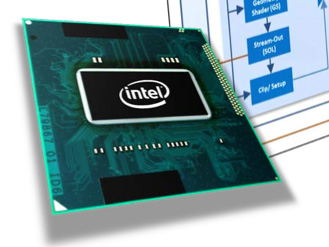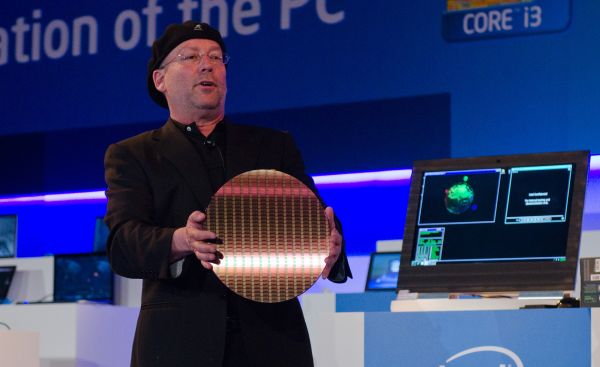Intel's Ivy Bridge Architecture Exposed
by Anand Lal Shimpi on September 17, 2011 2:00 AM EST- Posted in
- CPUs
- Intel
- Ivy Bridge
- IDF 2011
- Trade Shows
Five years ago Intel announced its ambitious tick-tock release cadence. We were doubtful that Intel could pull off such an aggressive schedule but with the exception of missing a few months here or there tick-tock has been a success. On years marked by a tick Intel introduces a new manufacturing process, while tock years keep manufacturing process the same and introduce a new microprocessor architecture. To date we've had three tocks (Conroe, Nehalem, Sandy Bridge) and two ticks (Penryn, Westmere). Sampling by the end of this year and shipping in the first half of next year will be Intel's third tick: Ivy Bridge.

Ivy Bridge (IVB) is the first chip to use Intel's 22nm tri-gate transistors, which will help scale frequency and reduce power consumption. As we already mentioned, mobile Ivy Bridge will be the first Intel CPU to bring four cores into a 35W TDP.
At a high level Ivy Bridge looks a lot like Sandy Bridge. It's still a monolithic die that features an integrated GPU. The entire die is built at 22nm, continuing Intel's march towards truly addressing integrated graphics performance. Ivy Bridge won't get rid of the need for a discrete GPU but, like Sandy Bridge, it is a step in the right direction.

Intel hasn't announced die size but transistor count has increased to approximately 1.4 billion (layout). This is up from 1.16 billion in Sandy Bridge, a 20.7% increase. With perfect scaling a 22nm Sandy Bridge die would be 47.3% the size of a 32nm die. Even with the increase in transistor count, it's a good bet that Ivy Bridge will be noticeably smaller than Sandy Bridge.
Motherboard & Chipset Support
Ivy Bridge is backwards compatible with existing LGA-1155 motherboards, although there will be a new chipset for Ivy Bridge and new motherboards to enable some features (e.g. PCI Express 3.0, native USB 3.0). The new chipset family falls under the 7-series banner. We'll see Z77, Z75, H77, Q77, Q75 and B75 available at or around launch.
| Chipset Comparison | ||||||||
| Z77 | Z75 | H77 | Z68 | P67 | H67 | |||
| CPU Support |
IVB LGA-1155 |
IVB LGA-1155 |
IVB LGA-1155 |
SNB/IVB LGA-1155 |
SNB/IVB LGA-1155 |
SNB/IVB LGA-1155 |
||
| CPU Overclocking | Yes | Yes | No | Yes | Yes | No | ||
| CPU PCIe Config |
1 x16 or 2 x8 or 1 x8 + 2 x4 PCIe 3.0 |
1 x16 or 2 x8 PCIe 3.0 |
1 x16 PCIe 3.0 |
1 x16 or 2 x8 or 1 x8 + 2 x4 PCIe 3.0 |
1 x16 or 2 x8 PCIe 3.0 |
1 x16 PCIe 3.0 | ||
| Processor Graphics Support | Yes | Yes | Yes | Yes | No | Yes | ||
| Intel SRT (SSD caching) | Yes | No | Yes | Yes | No | No | ||
| RAID Support | Yes | Yes | Yes | Yes | Yes | Yes | ||
| USB 2.0 Ports (3.0) | 14 (4) | 14 (4) | 14 (4) | 14 | 14 | 14 | ||
| SATA Total (Max Number of 6Gbps Ports) | 6 (2) | 6 (2) | 6 (2) | 6 (2) | 6 (2) | 6 (2) | ||
| PCIe Lanes | 8 (5GT/s) | 8 (5GT/s) | 8 (5GT/s) | 8 (5GT/s) | 8 (5GT/s) | 8 (5GT/s) | ||
As I mentioned above, Ivy Bridge finally supports USB 3.0 natively. The consumer 7-series chipsets feature 14 total USB ports, 4 of which are USB 3.0 capable. The CPU itself features 16 PCIe (1x16, 2x8 or 1x8 + 2x4) gen 3 lanes to be used for graphics and/or high performance IO. You will only see Gen 3 speeds on qualified motherboards. It's technically possible on 6-series motherboards but guaranteed on 7-series motherboards. The Z77 and H77 chipsets will support Intel's Smart Response Technology (SRT, aka SSD caching) which is a Z68 exclusive today.
SATA and chipset-attached PCIe slots haven't changed. Overclocking is supported on all Z-chipsets, while the H-chipset doesn't. All chipsets support Intel's HD Graphics, which is a departure from the Sandy Bridge mess where P67 didn't.










97 Comments
View All Comments
shiznit - Saturday, September 17, 2011 - link
Intel's APU is more integrated than AMD'sTypeS - Monday, September 19, 2011 - link
Guess you're one of those fanboys that just couldn't come back down from high of AMD's time in the spotlight with the Athlon 64?For someone who speaks of facts, you need to go check the architecture of both the SNB and Llano/Brazo cores before you say AMD has the more integrated approach.
AMD is just using marketing nonsense with calling their new CPU an "APU", just like when they called the Phenom X4s "true quad cores".
JonnyDough - Monday, September 19, 2011 - link
Marketing fluff is Intel's bag, right? Maybe you forget the whole "clock speed" fiasco. Selling P4's claiming they are faster than the competition, although they are not...At least consumers eventually caught on and OEMs began looking at AMD processors as well. :)
You all sound like fanboys though, who really cares who's right? We should just be excited about the TECH!
Kaihekoa - Saturday, September 17, 2011 - link
Lol with Intel's capital and recruiting experienced GPU engineers that "two year lead" will evaporate faster than boiling water. I don't know where you're getting your delusions of the mainstream market sapping up AMD's CPU/GPU combination marketing and products, but the average computer user doesn't use or need anything more than Intel's current generation of graphics. And as others have mentioned Intel's design is more integrated than AMDs on an engineering/design level.Yes, they have the more powerful GPU, but you have to be an idiot to think it's more integrated than Ivy Bridge. CPU performance and graphics good enough to power 2D and 3D accelerated media are the yardstick for PC performance for the vast majority of users. You're truly deluding yourself if you think the average computer user is playing The Witcher 2 and Deus Ex on their PCs with cards more powerful than IVB's. Even now with AMD's two year advantage, guess who owns the market for systems with a combined CPU/GPU? For integrated graphics? Wintel.
Am I an Intel fanboy? No, the last desktop system I built had an AMD CPU and discrete GPU, but you can't logically deny how well their business is doing now, and you'd be a food to think they would overlook the mainstream demand for a high-end APU. In the future when the market needs/wants it, Intel will have something equivalent or better to AMD/ATI.
Zoomer - Saturday, September 17, 2011 - link
Let's not forget drivers and game support, not to mention IQ. Last I checked, Intel graphics drivers were still pretty horrible.iwodo - Sunday, September 18, 2011 - link
Exactly. Designing Hardware is easy. You throw Money and Engineers you could be there in no time. Especially with the expertise from Intel.Software - on the other hand, takes time. No matter how many engineers you put in. Drivers is the problems Intel has to overcome.
JonnyDough - Monday, September 19, 2011 - link
I agree. Software is key. Intel is good at parts of it, AMD is better when it comes to keeping up with game developers. However, business markets make enthusiast markets look miniscule. Still, both are great competitors and we consumers just keep winning. :)iwodo - Sunday, September 18, 2011 - link
I forgot to add, there is a reason why Nvidia has more Software Engineers then Hardware.medi01 - Sunday, September 18, 2011 - link
It's actually the other way round. Pretty much any CPU starting from about 2008 is "more than good enough" for most users.BSMonitor - Sunday, September 18, 2011 - link
"In spite of the marketing hype from Intel it looks like they've conceded that AMD has the better system approach with APUs for mainstream consumers and laptops. CPU performance alone is no longer a valid yardstick for PC performance thanks to AMD's advance thinking and Llano. "This is utter nonsense. All AMD has done is transfer 400 of its shader units on to the CPU core. What you have with AMD is a 4-5 year old GPU combined with a 3 year old CPU.
Both sides of the coin yeild a huge YAWN from anyone looking for real performance.